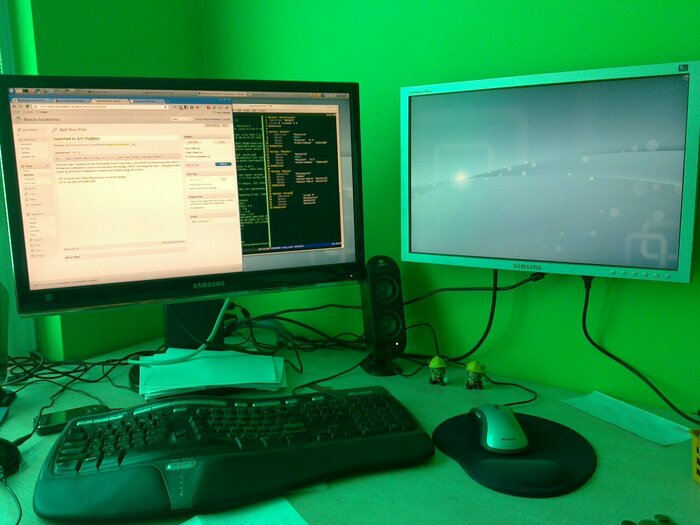This year I attended only one day of LinuxTag: Friday. There were many reasons for that but I am glad that I made at least that.
Wake up at 05:00 is hard… But I had a train to Berlin to catch. It was IC so power sockets were available and I watch some film and checked once again program for a day.
First attended talk was “Truths and Lies: Where’s the Open Source Modern Mobile Phone?” by Mickey Lauer. I like his presentations - they are always interesting and professional. His expertise in mobile phones running open systems warrant good talk. This time he did not mentioned FSO or oFono but told why Android (HTC Dream), WebOS (Palm Pre), Maemo (Nokia N900) are not open source systems. Why does it matter? Open system allows you do anything with device — you can even send it to space (like it was done with Openmoko GTA02).
I missed “Mobile Development with Qt and Qt Creator” presentation but Nokia guy at their stand explained later how does it work and why it is worth checking. In short: usable IDE with simulation of target device screen (from 1:1 display size to 1:1 resolution size).
Dirk Hohndel from Intel had a talk about “MeeGo - Linux for Mobile Devices”. Nice talk with presentation of current release on older laptop. Some background informations how it started from meeting of Intel and Nokia guys. And then someone asked will all existing applications will be rewritten to Qt (which is primary toolkit in MeeGo). Dirk tried to not answer it directly but finally said that no, current apps will stay with GTK+ (Clutter, MX) and only new ones will use Qt. I was not surprised — I know Moblin guys and their preferences when it comes to UI toolkit.
Next talk was about writing native code for Android and about how much can be done without going to Java world. As I am considering Android as a system for my next cell phone I was interested. But native does not free developer from Java. The idea is that you write C code, build it into library and then you need to write JNI which will be used from Java application to calls functions from native library. So ok, it gives speed but you still need to know Java ;(
“Debian Pure Blends” talk did not attracted many people. Andreas Tille told that many derivatives exists and some of them got merged back into Debian (like Skolelinux) while some does not even look like having sense in them.
“Debian GNU/kFreeBSD” summarised why Debian with FreeBSD kernel was made, what it gives and what is missing. Also note that NetBSD and OpenBSD based attempts were done but died few years ago. Is it worth using? I can not answer to that question. But if you need ZFS…
And at the end of a day Amit gave a talk about Linaro. There were about few people and most of them from Canonical.
But LinuxTag is not only talks. There are booths to visit, friends, coworkers and other people to meet etc.
Texas Instruments presented their low cost boards: HawkBoard, LeopardBoard and BeagleBoard XM. Each has own uses as they are using different processors and have other features. I hope that one day BB XM will replace my normal one but first they need to be available to buy (Digikey information is “6 weeks”).
Nokia had big stand where they presented Qt Creator software and Qt demos on N900 connected to flat TV. I asked some questions, got answers and now need to find some time to check their software and move my Protracker module player ahead.
OpenEmbedded had stand as well — this year not as a part of Tarent embedded area but small one in next hall. Florian Boor spent whole day manning it and presented few interesting boards. KaRo one (based on Sheeva cpu) was interesting — too bad that this is only armv5te ;(
Speaking of Tarent… Was nice to meet them, but did not had a time to talk much.
Met Matthias Klose (widely known as ‘doko’) who is Debian/Ubuntu toolchain maintainer. We had a short talk about our cooperation.
Conference ended, we went to centre for some food and then I had a train to catch to go back home.
Overall it was good to be there. But it was last time when I go for one day — it is simply too short to be able to meet everyone and talk longer then few minutes.
